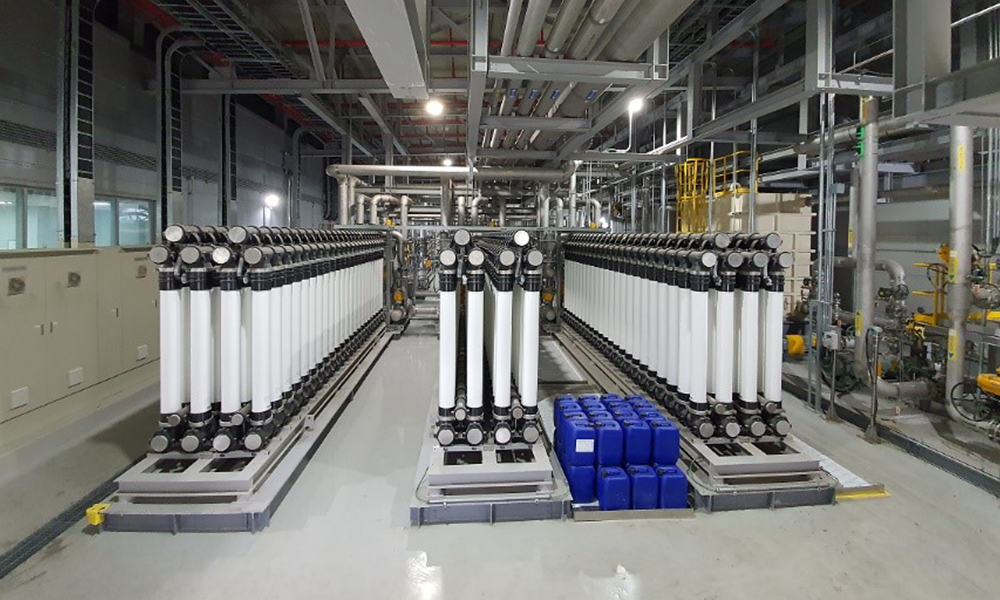Whether they be novels, feature films, or TV miniseries, works of dystopian fiction often paint a picture of a desecrated planet Earth. Characters battle over access to life-saving resources, including safe shelter, nutrient-rich foods, and drinkable water. This situation seems so far gone, viewers scarcely stop to think about resource supply in the modern-day. However, adopting the sentiment of “waste not, want not” is becoming more crucial than ever.
According to projections, the global water demand will be 40% more than the available supply by 2030, making what we do with water once we use it incredibly critical. Implementing meaningful wastewater discharge processes as part of manufacturing is essential to protecting this resource for the future.
As a reflection of its corporate values and commitment to the UN’s Sustainable Development Goals (SDGs), SK hynix has developed ridged wastewater discharge protocols. These efforts extend the lifecycle of industrial water, water mainly used in the cleaning process —allowing for the safe return of the resource to local waterways for the betterment of biodiversity.
What is wastewater discharge?
Quite simply, it is as named. In the case of semiconductors, the term wastewater discharge applies to any water dispelled from the manufacturing process into rivers and other bodies of water after treatment per water quality standards.
During production, industrial water is used in different processes, including wafer cleaning, machinery cooling, and wet etching. Specifically, ultra pure water, or UPW is water treated to be similar to ionized water, removing all soluble solids, bacteria, and organic matter. Afterward, the water must be treated again before it is released back into the environment.

Wastewater discharge recycling system at SK hynix fab
Expectations regarding wastewater discharge vary from country to country as individual governments determine regional regulations. South Korea is considered to have some of the strictest wastewater discharge management policies, and the responsibility of adequately processing falls on manufacturers. This is primarily due to the fact that South Korea is a geographically small country, meaning local water resources are precious and must be used sustainably. As a result, SK hynix’s domestic water management is extremely strict and of the highest priority
How does wastewater discharge impact local biodiversity?
Improperly treated wastewater discharge can affect local ecosystems in two critical ways; it can reduce the saturation of oxygen in the water and can result in wildlife ingesting hazardous chemicals. These effects are significant as they both have long-lasting impacts on the health of local biodiversity.
SK hynix takes great responsibility in properly processing the dispelled industrial water from its manufacturing sites and has gone above and beyond to introduce initiatives that are helping to reclaim wastewater discharge. The process to reclaim water involves retreating wastewater discharge in a manner that makes it eligible for reuse. In fact, by 2030, SK hynix aims to triple the 21.63 million cubic meters of water it reclaimed in 2019 in its South Korean fabs.
How does SK hynix set the standard in wastewater discharge management?
For one, the company’s approach doesn’t end at properly treating wastewater discharge; it extends to reducing the volume of water it uses as well. In 2020, SK hynix conserved 42.77 million cubic meters of water, approximately the same amount used by 400,000 Koreans annually. The company was also awarded the Grand Prize in the CDP Water Security program due to its reduction and reuse efforts.
Extending the positive impact of the water it uses, SK hynix also developed a small hydropower station in its Icheon location. The hydropower station leverages the flow of wastewater discharge through an elevation change in its treatment center, thus creating a source of renewable energy on-site that produced 174MWh of power in 2020.

The 45-kW hydropower generator at SK hynix’x Icheon wastewater discharge treatment facility
When wastewater discharge finally must be dispelled, SK hynix is extremely sensitive about its release. Achieving a Good Water wastewater discharge classification was essential for SK hynix. It prides itself on maintaining a premium wastewater discharge quality to create a healthy habitat for all local wild and plant life.
SK hynix and Microsoft came together last year, signing a memorandum of understanding to pursue a study of the impact of purified water released into the Anseong stream, which runs near the future SK hynix site in Yongin. This research will leverage Microsoft’s AI technology Azure to observe and record changes to the local biodiversity. The new semiconductor cluster project in Yongin is expected to release significant volumes of purified water. The research project’s initial hypothesis is that the increased volume of water in the stream will result in a more active ecosystem due to a rise in the quantity of prey.
SK hynix has been actively performing similar research since 2019, monitoring aquatic ecosystems at five locations. The monitoring includes the analysis of several factors, such as sediment, topographical structures, and wildlife. Temperature is also very closely monitored, and temperature management facilities are installed to lower the temperature of dispelled wastewater discharge.
In Jukdang stream, located near SK hynix’s Icheon site, cameras recently spotted a Eurasian otter. As a Class 1 endangered species, the otter is of particular interest to SK hynix. The company has implemented more frequent monitoring of this stream and applied even stricter wastewater discharge management standards. The stream is also home to many other important wildlife, including leopard cats, mandarin ducks, and even the odd eagle and owl.

The Eurasian otter it its Jukdang stream home
SK hynix distinguishes itself from its peers as a champion of sustainable practices by pursuing environmental, social, and corporate governance (ESG) management policies with fierce determination and enthusiasm. The company strives to continue identifying, developing, and optimizing new sustainable processes to reduce its environmental impact. Improving the quality of wastewater discharge expelled from its manufacturing process may only be a drop in the global pond of sustainability, but ripples quickly become waves.






